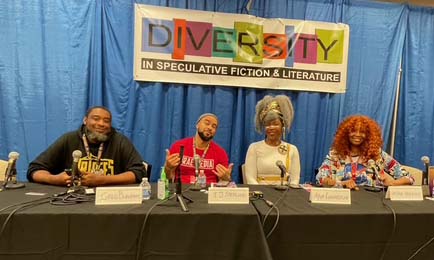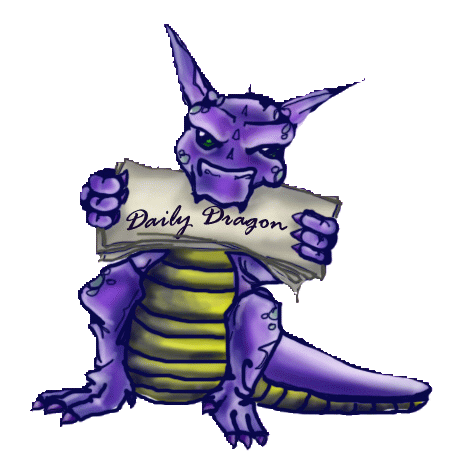
On Friday morning at 10AM in Hyatt Hanover AB, a panel of Black comics creators discussed their routes to the industry and the ways they incorporate Black history and culture into their work. Sha Herring first asked the group, which included Greg Burnham, T.J Sterling, and Afua Richardson, when they each knew that creating comics was the path for them.
Sterling said his first visit to a comic shop enthralled him with the colors and the characters. He wanted to know what this world was, and how he could be involved. This was in the 1990s, which he described as the best era of comics because of groundbreaking stories. He started drawing superheroes, then moved into manga and gaming, including Pokémon, though they weren’t cool at the time.
Burnham grew up in Idaho, in a town so small that there wasn’t a movie theater within an hour’s drive. When he was in the second grade, he was drawn by the novelization of The Empire Strikes Back at the school book fair. The vendor refused to sell it to him because she thought it was above his reading level. His teacher noticed that he was upset. When he told her why, she went to the vendor, had an apparently heated exchange, and came back with the book. Burnham sat down with the book and a dictionary, looking up words he didn’t know and visualizing as he read. When he and his brother played G.I. Joe, they had to set up the room the way they thought it should look, and he mentally played out the story.
The Burnham family moved to another small town, this one in Missouri. An elderly woman who was an author talked to his school class, and he was struck that she had written a book. He immediately bought an issue of Omega Man and was excited to read a comic about a Black hero created by a Black man [Alonzo L. Washington]. Sometime later, Arsenio Hall mentioned Brotherman, and then Milestone Media [a coalition of Black writers and artists] launched Milestone Comics. When Burnham moved to Atlanta in 1999, he decided to create comics.
Richardson loved art, colors, and music from an early age. She loved the Vincent Price narration for Peter and the Wolf and the way each character had a musical theme. When she purchased Giant Size X-Men [#1], she was hooked. Finally old enough to have an allowance, she bought comics, which offered a different world. At one point, she had more comics than clothes in her closet. Her mother threw the comics out, so Richardson started carrying a small sketchbook and keeping it with her. In the ‘90s, she joined a female hip-hop crew called The Anomalies as a human beatbox artist. She went to comics shows, bought work from artists, and then showed them a single piece of her work and asked for critiques. She eventually got a job with Image Comics, to draw an anthology about New York City with robots.
Sterling said, “Seeing us in a book was something.” He wanted to make such books. He also went to conventions with his portfolio. Creating, he believes, is a learning process, an exercise in expression. He likes to offer the audience something they haven’t seen before, and looks for opportunities to do that, such as a “Black cyberpunk chick.” His Joystick Angels are kids who want to save the universe while Okemus shows the effects of police brutality on Black people.
Burnham publishes Tuskegee Heirs, futuristic science fiction about successors to the Tuskegee Airmen. His Bridges, which features Black girls as superheroes, is his first superhero book other than his work for DC. Bridges is lighthearted and focuses on relationships. He uses music and sports to infuse Black culture in the books, and thinks it isn’t necessary to be heavy-handed.
Richardson’s name, Afua, is Ghanian for “Girl Born on Friday.” When she learned that, she set out to learn more about African culture. She is fascinated by traditions, especially why people hold things sacred and venerate them, and she loves putting such things into stories. Growing up in New York, she had friends from a wide range of world cultures. She learned from and absorbed their traditions. When she got the call from Marvel to provide the art for Black Panther: World of Wakanda, she put African symbols on the covers, specifically giving T’Challa one related to kingship.
Herring noted that movies from the 1930s and up had no “people who looked like us” in futuristic stories. She asked whether the panelists thought tech offered ways to influence comics.
Sterling believes healthy tech, as opposed to AI, is always good. He has QR codes in Joystick Angels that lead to the book’s custom soundtrack. Richardson attended an aerospace convention and found that the STEM people wanted to bring more young people into science. She feels comics and entertainment are a gateway for that. The Jetsons used Facetime, a robot cleaner, and flying cars. Tech doesn’t have to be doom and gloom. Artists with imagination use tech to solve problems.
Burnham has plans for adapting his work to animation. He has stepped away from option deals where people wanted to change the Black characters. Options are problematic, he says, because people can license a property, shelve it, and, a few years later, produce something similar enough that the original creators can’t compete. Even if an option is cancelled, the company that bought it may still retain rights.
Herring said the moral of the story is to protect intellectual property and not work for free. Sterling added, “Don’t do anything for free. Use discernment to bring things that enrich you.”
